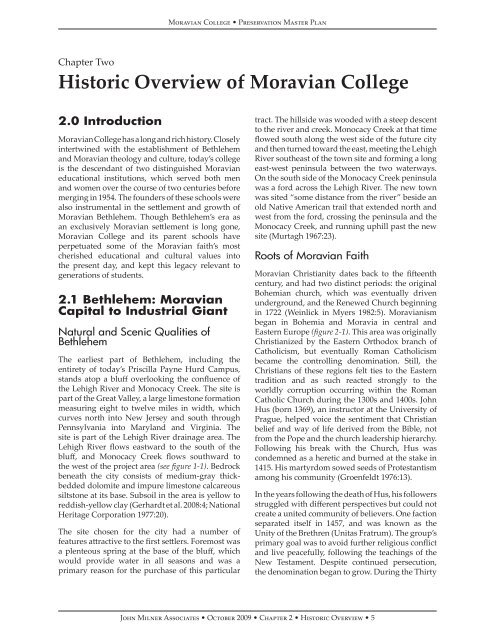Moravian Preservation Master Plan.indb - Society for College and ...
Moravian Preservation Master Plan.indb - Society for College and ...
Moravian Preservation Master Plan.indb - Society for College and ...
You also want an ePaper? Increase the reach of your titles
YUMPU automatically turns print PDFs into web optimized ePapers that Google loves.
<strong>Moravian</strong> <strong>College</strong> • <strong>Preservation</strong> <strong>Master</strong> <strong>Plan</strong><br />
Chapter Two<br />
Historic Overview of <strong>Moravian</strong> <strong>College</strong><br />
2.0 Introduction<br />
<strong>Moravian</strong> <strong>College</strong> has a long <strong>and</strong> rich history. Closely<br />
intertwined with the establishment of Bethlehem<br />
<strong>and</strong> <strong>Moravian</strong> theology <strong>and</strong> culture, today’s college<br />
is the descendant of two distinguished <strong>Moravian</strong><br />
educational institutions, which served both men<br />
<strong>and</strong> women over the course of two centuries be<strong>for</strong>e<br />
merging in 1954. The founders of these schools were<br />
also instrumental in the settlement <strong>and</strong> growth of<br />
<strong>Moravian</strong> Bethlehem. Though Bethlehem’s era as<br />
an exclusively <strong>Moravian</strong> settlement is long gone,<br />
<strong>Moravian</strong> <strong>College</strong> <strong>and</strong> its parent schools have<br />
perpetuated some of the <strong>Moravian</strong> faith’s most<br />
cherished educational <strong>and</strong> cultural values into<br />
the present day, <strong>and</strong> kept this legacy relevant to<br />
generations of students.<br />
2.1 Bethlehem: <strong>Moravian</strong><br />
Capital to Industrial Giant<br />
Natural <strong>and</strong> Scenic Qualities of<br />
Bethlehem<br />
The earliest part of Bethlehem, including the<br />
entirety of today’s Priscilla Payne Hurd Campus,<br />
st<strong>and</strong>s atop a bluff overlooking the confluence of<br />
the Lehigh River <strong>and</strong> Monocacy Creek. The site is<br />
part of the Great Valley, a large limestone <strong>for</strong>mation<br />
measuring eight to twelve miles in width, which<br />
curves north into New Jersey <strong>and</strong> south through<br />
Pennsylvania into Maryl<strong>and</strong> <strong>and</strong> Virginia. The<br />
site is part of the Lehigh River drainage area. The<br />
Lehigh River flows eastward to the south of the<br />
bluff, <strong>and</strong> Monocacy Creek flows southward to<br />
the west of the project area (see figure 1-1). Bedrock<br />
beneath the city consists of medium-gray thickbedded<br />
dolomite <strong>and</strong> impure limestone calcareous<br />
siltstone at its base. Subsoil in the area is yellow to<br />
reddish-yellow clay (Gerhardt et al. 2008:4; National<br />
Heritage Corporation 1977:20).<br />
The site chosen <strong>for</strong> the city had a number of<br />
features attractive to the first settlers. Foremost was<br />
a plenteous spring at the base of the bluff, which<br />
would provide water in all seasons <strong>and</strong> was a<br />
primary reason <strong>for</strong> the purchase of this particular<br />
tract. The hillside was wooded with a steep descent<br />
to the river <strong>and</strong> creek. Monocacy Creek at that time<br />
flowed south along the west side of the future city<br />
<strong>and</strong> then turned toward the east, meeting the Lehigh<br />
River southeast of the town site <strong>and</strong> <strong>for</strong>ming a long<br />
east-west peninsula between the two waterways.<br />
On the south side of the Monocacy Creek peninsula<br />
was a <strong>for</strong>d across the Lehigh River. The new town<br />
was sited “some distance from the river” beside an<br />
old Native American trail that extended north <strong>and</strong><br />
west from the <strong>for</strong>d, crossing the peninsula <strong>and</strong> the<br />
Monocacy Creek, <strong>and</strong> running uphill past the new<br />
site (Murtagh 1967:23).<br />
Roots of <strong>Moravian</strong> Faith<br />
<strong>Moravian</strong> Christianity dates back to the fifteenth<br />
century, <strong>and</strong> had two distinct periods: the original<br />
Bohemian church, which was eventually driven<br />
underground, <strong>and</strong> the Renewed Church beginning<br />
in 1722 (Weinlick in Myers 1982:5). <strong>Moravian</strong>ism<br />
began in Bohemia <strong>and</strong> Moravia in central <strong>and</strong><br />
Eastern Europe (figure 2-1). This area was originally<br />
Christianized by the Eastern Orthodox branch of<br />
Catholicism, but eventually Roman Catholicism<br />
became the controlling denomination. Still, the<br />
Christians of these regions felt ties to the Eastern<br />
tradition <strong>and</strong> as such reacted strongly to the<br />
worldly corruption occurring within the Roman<br />
Catholic Church during the 1300s <strong>and</strong> 1400s. John<br />
Hus (born 1369), an instructor at the University of<br />
Prague, helped voice the sentiment that Christian<br />
belief <strong>and</strong> way of life derived from the Bible, not<br />
from the Pope <strong>and</strong> the church leadership hierarchy.<br />
Following his break with the Church, Hus was<br />
condemned as a heretic <strong>and</strong> burned at the stake in<br />
1415. His martyrdom sowed seeds of Protestantism<br />
among his community (Groenfeldt 1976:13).<br />
In the years following the death of Hus, his followers<br />
struggled with different perspectives but could not<br />
create a united community of believers. One faction<br />
separated itself in 1457, <strong>and</strong> was known as the<br />
Unity of the Brethren (Unitas Fratrum). The group’s<br />
primary goal was to avoid further religious conflict<br />
<strong>and</strong> live peacefully, following the teachings of the<br />
New Testament. Despite continued persecution,<br />
the denomination began to grow. During the Thirty<br />
John Milner Associates • October 2009 • Chapter 2 • Historic Overview • 5

















